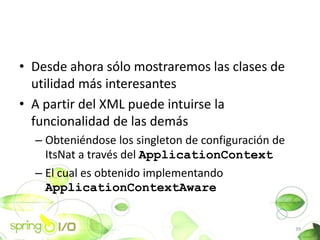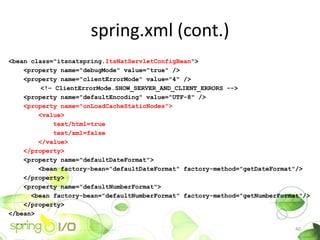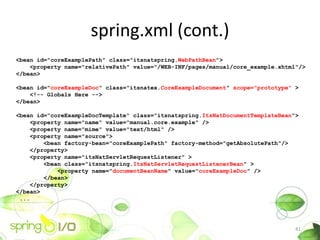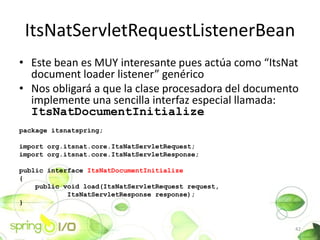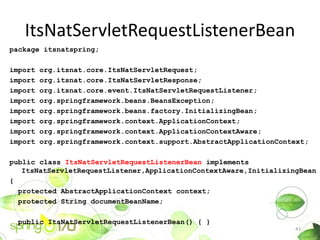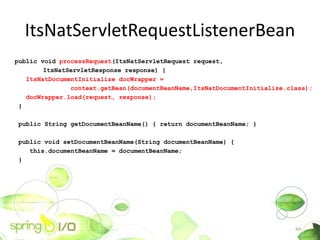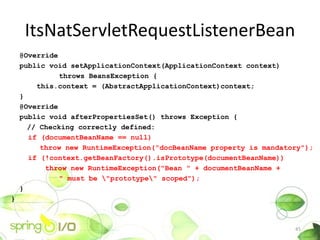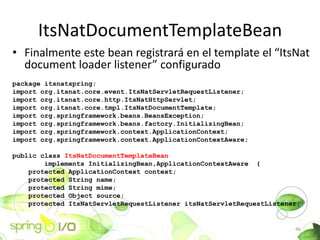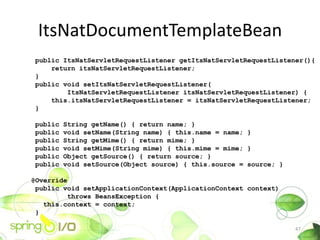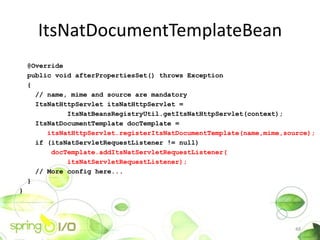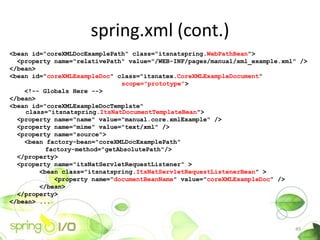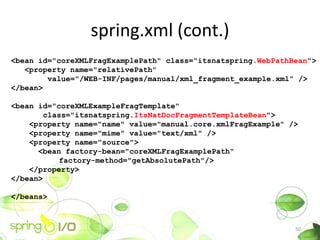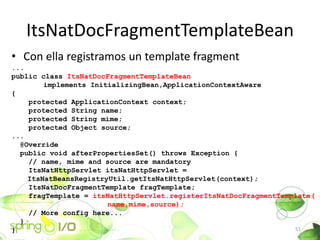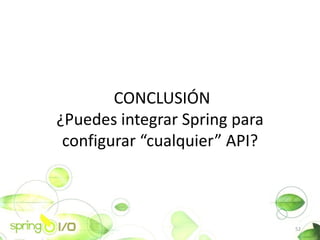Configurar con spring un api no basado en spring
- 1. CONFIGURAR CON SPRING UN API NO BASADO EN SPRING Jose Mar©¬a Arranz Santamar©¬a Madrid (Espa?a) 17-18 Febrero 2011 1
- 2. EL PROBLEMA 2
- 3. EL PROBLEMA ? Spring naci©« como una herramienta de configuraci©«n e integraci©«n de tecnolog©¬as dispares ? No siempre podemos esperar que dichas tecnolog©¬as dispares se configuren necesariamente con Spring ?Para eso existe Spring! 3
- 4. EL PROBLEMA ? ItsNat es un framework web Java que tiene su propio sistema de configuraci©«n ? ItsNat se configura de la forma m©ós potente y flexible que existe A trav©”s de llamadas a m©”todos ? Desde el d©¬a 0 se concibi©« para poder ser Ī░sobrecargadoĪ▒ con APIs de m©ós alto nivel, por ejemplo conĪŁ ?Spring! 4
- 5. 5
- 6. TRANQUILO ?ESTA NO SER? UNA CLASE DE ItsNat! ? 6
- 7. APRENDEREMOS ALGUNOS TRUCOS DE Spring 7
- 8. PERO HAY QUE CONOCER C?MO SE CONFIGURA ItsNat PARA APLICAR Spring 8
- 9. EJEMPLO ItsNat Ī░PUROĪ▒: el servlet ? ItsNat no define un servlet concreto, el usuario debe crear uno (o m©ós) ©C Se configura en el m©”todo init ? La inmensa mayor©¬a de los flags de configuraci©«n usados son opcionales (coinciden con el valor por defecto) public class servlet extends HttpServletWrapper { public void init(ServletConfig config) throws ServletException { super.init(config); ItsNatHttpServlet itsNatServlet = getItsNatHttpServlet(); ItsNatServletConfig itsNatConfig = itsNatServlet.getItsNatServletConfig(); ItsNatServletContext itsNatCtx = itsNatConfig.getItsNatServletContext(); 9
- 10. EJEMPLO ItsNat Ī░PUROĪ▒ : el servlet ? ItsNatHttpServlet, ItsNatServletConfig y ItsNatServletContext son los objetos ra©¬z de configuraci©«n en ItsNat itsNatCtx.setMaxOpenDocumentsBySession(6); String serverInfo = getServletContext().getServerInfo(); boolean gaeEnabled = serverInfo.startsWith( "Google App Engine"); itsNatCtx.setSessionReplicationCapable(gaeEnabled); itsNatCtx.setSessionSerializeCompressed(false); itsNatCtx.setSessionExplicitSerialize(false); 10
- 11. EJEMPLO ItsNat Ī░PUROĪ▒ : el servlet itsNatConfig.setDebugMode(true); itsNatConfig.setClientErrorMode( ClientErrorMode.SHOW_SERVER_AND_CLIENT_ERRORS); itsNatConfig.setLoadScriptInline(true); itsNatConfig.setFastLoadMode(true); itsNatConfig.setCommMode(CommMode.XHR_ASYNC_HOLD); itsNatConfig.setEventTimeout(-1); itsNatConfig.setOnLoadCacheStaticNodes("text/html",true); itsNatConfig.setOnLoadCacheStaticNodes("text/xml",false); itsNatConfig.setNodeCacheEnabled(true); 11
- 12. EJEMPLO ItsNat Ī░PUROĪ▒ : el servlet itsNatConfig.setDefaultEncoding("UTF-8"); itsNatConfig.setUseGZip(UseGZip.SCRIPT); itsNatConfig.setDefaultDateFormat( DateFormat.getDateInstance(DateFormat.DEFAULT,Locale.US)); itsNatConfig.setDefaultNumberFormat( NumberFormat.getInstance(Locale.US)); itsNatConfig.setEventDispatcherMaxWait(0); itsNatConfig.setEventsEnabled(true); itsNatConfig.setScriptingEnabled(true); itsNatConfig.setUsePatternMarkupToRender(false); itsNatConfig.setAutoCleanEventListeners(true); 12
- 13. EJEMPLO ItsNat Ī░PUROĪ▒ : el servlet ? Ahora registramos en el servlet un template core_example.xhtml con su procesador de carga CoreExampleLoadListener ©C Ejemplo sencillo de p©ógina HTML con AJAX String pathPrefix = getServletContext().getRealPath("/"); pathPrefix += "/WEB-INF/pages/manual/"; ItsNatDocumentTemplate docTemplate; docTemplate = itsNatServlet.registerItsNatDocumentTemplate( "manual.core.example","text/html", pathPrefix + "core_example.xhtml"); docTemplate.addItsNatServletRequestListener( new CoreExampleLoadListener()); 13
- 14. EJEMPLO ItsNat Ī░PUROĪ▒ : el servlet ? Y otro ejemplo de generaci©«n de p©ógina XML docTemplate = itsNatServlet.registerItsNatDocumentTemplate( "manual.core.xmlExample","text/xml", pathPrefix + "xml_example.xml"); docTemplate.addItsNatServletRequestListener( new CoreXMLExampleLoadListener()); ? Que a su vez inserta un template fragment ©C Los template fragment no tienen procesador ItsNatDocFragmentTemplate docFragTemplate; docFragTemplate = itsNatServlet.registerItsNatDocFragmentTemplate( "manual.core.xmlFragExample","text/xml", pathPrefix + "xml_fragment_example.xml"); 14
- 15. EJEMPLO ItsNat Ī░PUROĪ▒ ? <root>/WEB-INF/pages/manual/core_example.xhtml <!DOCTYPE html PUBLIC "-//W3C//DTD XHTML 1.0 Strict//EN" "http://www.w3.org/TR/xhtml1/DTD/xhtml1-strict.dtd"> <html xmlns="http://www.w3.org/1999/xhtml"> <head><title>ItsNat Core Example</title></head> <body> <h3>ItsNat Core Example</h3> <div itsnat:nocache="true" xmlns:itsnat="http://itsnat.org/itsnat"> <div id="clickableId1">Clickable Elem 1</div> <br /> <div id="clickableId2">Clickable Elem 2</div> </div> </body> </html> 15
- 16. EJEMPLO ItsNat Ī░PUROĪ▒ ? CoreExampleLoadListener es un mero lanzador del gestor del documento en cada carga de p©ógina public class CoreExampleLoadListener implements ItsNatServletRequestListener { public CoreExampleLoadListener() {} public void processRequest(ItsNatServletRequest request, ItsNatServletResponse response) { ItsNatHTMLDocument itsNatDoc = (ItsNatHTMLDocument)request.getItsNatDocument(); new CoreExampleDocument(itsNatDoc); } } 16
- 17. EJEMPLO ItsNat Ī░PUROĪ▒ ? CoreExampleDocument gestiona el estado de la p©ógina recibiendo los eventos AJAX public class CoreExampleDocument implements EventListener { protected ItsNatHTMLDocument itsNatDoc; protected Element clickElem1; protected Element clickElem2; public CoreExampleDocument(ItsNatHTMLDocument itsNatDoc) { this.itsNatDoc = itsNatDoc; load(); } ... 17
- 18. EJEMPLO ItsNat Ī░PUROĪ▒ 18
- 19. EJEMPLO ItsNat Ī░PUROĪ▒ ? <root>/WEB-INF/pages/manual/xml_example.xml <?xml version='1.0' encoding='UTF-8' ?> <discs> <itsnat:include name="manual.core.xmlFragExample" xmlns:itsnat="http://itsnat.org/itsnat" /> <cdList> <cd> <title>Tittle</title> <artist>Artist</artist> <songs> <song>Song Pattern</song> </songs> </cd> </cdList> </discs> 19
- 20. EJEMPLO ItsNat Ī░PUROĪ▒ ? <root>/WEB-INF/pages/manual/xml_fragment_example.xml <?xml version='1.0' encoding='UTF-8' ?> <root> <title>CD List</title> <subtitle>in XML</subtitle> </root> 20
- 21. EJEMPLO ItsNat Ī░PUROĪ▒ ? CoreXMLExampleLoadListener : como en XML no hay AJAX no necesitamos una clase wrapper de documento. Se incluye el template fragment manual.core.xmlFragExample public class CoreXMLExampleLoadListener implements ItsNatServletRequestListener { public CoreXMLExampleLoadListener() { } public void processRequest(ItsNatServletRequest request, ItsNatServletResponse response) { ItsNatDocument itsNatDoc = request.getItsNatDocument(); Document doc = itsNatDoc.getDocument(); Element discsElem = doc.getDocumentElement(); ... 21
- 22. EJEMPLO ItsNat Ī░PUROĪ▒ 22
- 23. ItsNat Springization 23
- 24. OBJETIVOS 1. Un ©▓nico servlet gen©”rico reutilizable: itsnatspring.itsnatservlet 2. La configuraci©«n se realizar©ó totalmente en un archivo XML de Spring en el classpath: itsnatex/spring.xml 3. Las ©▓nicas clases del usuario ser©ón las clases contenedoras del documento ItsNat (=p©ógina): itsnatex.CoreExampleDocument itsnatex.CoreXMLExampleDocument 24
- 25. CONSECUENCIAS ? Adem©ós del servlet gen©”rico reutilizable necesitaremos una serie de clases de utilidad tambi©”n gen©”ricas y reutilizables ? Dichas clases quedar©ón incompletas, s©«lo cubriremos las necesidades de este ejemplo ©C ItsNat tiene m©ós m©”todos de configuraci©«n 25
- 26. EL SERVLET package itsnatspring; import javax.servlet.ServletConfig; import javax.servlet.ServletException; import org.itsnat.core.http.HttpServletWrapper; import org.itsnat.core.http.ItsNatHttpServlet; import org.springframework.context.ApplicationContext; import org.springframework.context.support.ClassPathXmlApplicationContext; import org.springframework.context.support.GenericApplicationContext; public class itsnatservlet extends HttpServletWrapper { public void init(ServletConfig config) throws ServletException { super.init(config); ItsNatHttpServlet itsNatServlet = getItsNatHttpServlet(); GenericApplicationContext rootContext = new GenericApplicationContext(); ItsNatBeansRegistryUtil.registerSingletons(rootContext, itsNatServlet); rootContext.refresh(); 26
- 27. EL SERVLET String springXMLPath = config.getInitParameter("spring_config"); if (springXMLPath == null) throw new RuntimeException("spring_config initialization parameter is not specified in web.xml"); ApplicationContext context = new ClassPathXmlApplicationContext( new String[] {springXMLPath},rootContext); } } ? Se registran como singleton los objetos de configuraci©«n de ItsNat en un ApplicationContext gen©”rico ra©¬z y se carga en otro nuevo nuestro XML Spring 27
- 28. ItsNatBeansRegistryUtil package itsnatspring; import org.itsnat.core.ItsNatServletConfig; import org.itsnat.core.ItsNatServletContext; import org.itsnat.core.http.ItsNatHttpServlet; import org.springframework.beans.factory.config.ConfigurableListableBeanFactory; import org.springframework.context.ApplicationContext; import org.springframework.context.support.AbstractApplicationContext; public class ItsNatBeansRegistryUtil { public final static String itsNatHttpServletBean = "itsNatHttpServlet"; public final static String itsNatServletConfigBean = "itsNatServletConfig"; public final static String itsNatServletContextBean = "itsNatServletContext"; public static ItsNatHttpServlet getItsNatHttpServlet(ApplicationContext context) { return context.getBean(itsNatHttpServletBean,ItsNatHttpServlet.class); } public static ItsNatServletConfig getItsNatServletConfig(ApplicationContext context){ return context.getBean(itsNatServletConfigBean,ItsNatServletConfig.class); } public static ItsNatServletContext getItsNatServletContext(ApplicationContext context){ return context.getBean(itsNatServletContextBean,ItsNatServletContext.class); } 28
- 29. ItsNatBeansRegistryUtil public static void registerSingletons(AbstractApplicationContext context, ItsNatHttpServlet itsNatServlet) { ItsNatServletConfig itsNatServletCofig = itsNatServlet.getItsNatServletConfig(); ItsNatServletContext itsNatServletContext = itsNatServletCofig.getItsNatServletContext(); ConfigurableListableBeanFactory beanFact = context.getBeanFactory(); beanFact.registerSingleton(itsNatHttpServletBean,itsNatServlet); beanFact.registerSingleton(itsNatServletConfigBean,itsNatServletCofig); beanFact.registerSingleton(itsNatServletContextBean,itsNatServletContext); } } ? El resultado es el registro manual como singleton de los objetos de conf. de ItsNat 29
- 30. web.xml <?xml version="1.0" encoding="UTF-8"?> <web-app version="3.0" xmlns="http://java.sun.com/xml/ns/javaee" xmlns:xsi="http://www.w3.org/2001/XMLSchema-instance" xsi:schemaLocation="http://java.sun.com/xml/ns/javaee http://java.sun.com/xml/ns/javaee/web-app_3_0.xsd"> <servlet> <servlet-name>itsnatservlet</servlet-name> <servlet-class>itsnatspring.itsnatservlet</servlet-class> <init-param> <param-name>spring_config</param-name> <param-value>itsnatex/spring.xml</param-value> </init-param> </servlet> <servlet-mapping> <servlet-name>itsnatservlet</servlet-name> <url-pattern>/itsnatservlet</url-pattern> </servlet-mapping> <session-config> <session-timeout>30</session-timeout> </session-config> </web-app> 30
- 31. spring.xml <?xml version="1.0" encoding="UTF-8"?> <beans xmlns="http://www.springframework.org/schema/beans" xmlns:xsi="http://www.w3.org/2001/XMLSchema-instance" xsi:schemaLocation="http://www.springframework.org/schema/beans http://www.springframework.org/schema/beans/spring-beans-3.0.xsd http://www.springframework.org/schema/util http://www.springframework.org/schema/util/spring-util-3.0.xsd"> <bean class="itsnatspring.ItsNatServletContextBean"> <property name="maxOpenDocumentsBySession" value="10" /> <property name="sessionReplicationCapable" value="false" /> <property name="sessionSerializeCompressed" value="false" /> <property name="sessionExplicitSerialize" value="false" /> </bean> 31
- 32. ItsNatServletContextBean ? Este bean singleton de utilidad nos sirve para recordar los flags definidos y al final registrarlos de forma efectiva en el ItsNatServletContext ©C Como se necesita el ApplicationContext implementamos ApplicationContextAware ©C Como necesitamos actuar cuando termine la configuraci©«n del bean, implementamos InitializingBean 32
- 33. ItsNatServletContextBean package itsnatspring; import org.itsnat.core.ItsNatServletContext; import org.springframework.beans.BeansException; import org.springframework.beans.factory.InitializingBean; import org.springframework.context.ApplicationContext; import org.springframework.context.ApplicationContextAware; public class ItsNatServletContextBean implements InitializingBean,ApplicationContextAware { protected ApplicationContext context; protected Integer maxOpenDocumentsBySession; protected Boolean sessionReplicationCapable; protected Boolean sessionSerializeCompressed; protected Boolean sessionExplicitSerialize; public ItsNatServletContextBean() { } 33
- 34. ItsNatServletContextBean public int getMaxOpenDocumentsBySession() { return maxOpenDocumentsBySession; } public void setMaxOpenDocumentsBySession(int maxOpenDocumentsBySession){ this.maxOpenDocumentsBySession = maxOpenDocumentsBySession; } public boolean getSessionReplicationCapable() { return sessionReplicationCapable; } public void setSessionReplicationCapable( boolean sessionReplicationCapable) { this.sessionReplicationCapable = sessionReplicationCapable; } public boolean getSessionSerializeCompressed() { return sessionSerializeCompressed; } public void setSessionSerializeCompressed( boolean sessionSerializeCompressed) { this.sessionSerializeCompressed = sessionSerializeCompressed; } 34
- 35. ItsNatServletContextBean public boolean getSessionExplicitSerialize() { return sessionExplicitSerialize; } public void setSessionExplicitSerialize(boolean sessionExplicitSerialize){ this.sessionExplicitSerialize = sessionExplicitSerialize; } @Override public void setApplicationContext(ApplicationContext context) throws BeansException { this.context = context; } @Override public void afterPropertiesSet() throws Exception { ItsNatServletContext itsNatServletContext = ItsNatBeansRegistryUtil.getItsNatServletContext(context); if (maxOpenDocumentsBySession != null) itsNatServletContext.setMaxOpenDocumentsBySession(maxOpenDocumentsBySession); if (sessionReplicationCapable != null) itsNatServletContext.setSessionReplicationCapable(sessionReplicationCapable); if (sessionSerializeCompressed != null) itsNatServletContext.setSessionSerializeCompressed(sessionSerializeCompressed); if (sessionExplicitSerialize != null) itsNatServletContext.setSessionExplicitSerialize(sessionExplicitSerialize); } } 35
- 36. spring.xml (cont.) <bean id="defaultLocale" class="itsnatspring.LocaleBean" > <property name="language" value="en" /> <property name="country" value="US" /> </bean> <bean id="defaultDateFormat" class="itsnatspring.DateFormatBean" > <property name="style" value="2" /> <!-- DateFormat.DEFAULT --> <property name="locale"> <bean factory-bean="defaultLocale" factory-method="getLocale"/> </property> </bean> <bean id="defaultNumberFormat" class="itsnatspring.NumberFormatBean" > <property name="locale"> <bean factory-bean="defaultLocale" factory-method="getLocale" /> </property> </bean> ... 36
- 37. LocaleBean ? Este Ī░factory beanĪ▒ nos permite configurar un objeto y hacerlo p©▓blico a trav©”s del Ī░factory methodĪ▒ getLocale() package itsnatspring; import java.util.Locale; import org.springframework.beans.factory.InitializingBean; public class LocaleBean implements InitializingBean { protected String language; protected String country; protected Locale locale; public LocaleBean() { } public String getCountry() { return country; } public void setCountry(String country) { this.country = country; } public String getLanguage() { return language; } 37
- 38. LocaleBean public void setLanguage(String language) { this.language = language; } public Locale getLocale() { return locale; } @Override public void afterPropertiesSet() throws Exception { Locale[] availablelocales = Locale.getAvailableLocales(); for(Locale locale : availablelocales) if (locale.getLanguage().equals(language) && locale.getCountry().equals(country)) { this.locale = locale; return; } this.locale = new Locale(language,country); } } 38
- 39. ? Desde ahora s©«lo mostraremos las clases de utilidad m©ós interesantes ? A partir del XML puede intuirse la funcionalidad de las dem©ós ©C Obteni©”ndose los singleton de configuraci©«n de ItsNat a trav©”s del ApplicationContext ©C El cual es obtenido implementando ApplicationContextAware 39
- 40. spring.xml (cont.) <bean class="itsnatspring.ItsNatServletConfigBean"> <property name="debugMode" value="true" /> <property name="clientErrorMode" value="4" /> <!©C ClientErrorMode.SHOW_SERVER_AND_CLIENT_ERRORS --> <property name="defaultEncoding" value="UTF-8" /> <property name="onLoadCacheStaticNodes"> <value> text/html=true text/xml=false </value> </property> <property name="defaultDateFormat"> <bean factory-bean="defaultDateFormat" factory-method="getDateFormat"/> </property> <property name="defaultNumberFormat"> <bean factory-bean="defaultNumberFormat" factory-method="getNumberFormat"/> </property> </bean> ... 40
- 41. spring.xml (cont.) <bean id="coreExamplePath" class="itsnatspring.WebPathBean"> <property name="relativePath" value="/WEB-INF/pages/manual/core_example.xhtml"/> </bean> <bean id="coreExampleDoc" class="itsnatex.CoreExampleDocument" scope="prototype" > <!-- Globals Here --> </bean> <bean id="coreExampleDocTemplate" class="itsnatspring.ItsNatDocumentTemplateBean"> <property name="name" value="manual.core.example" /> <property name="mime" value="text/html" /> <property name="source"> <bean factory-bean="coreExamplePath" factory-method="getAbsolutePath"/> </property> <property name="itsNatServletRequestListener" > <bean class="itsnatspring.ItsNatServletRequestListenerBean" > <property name="documentBeanName" value="coreExampleDoc" /> </bean> </property> </bean> ... 41
- 42. ItsNatServletRequestListenerBean ? Este bean es MUY interesante pues act©▓a como Ī░ItsNat document loader listenerĪ▒ gen©”rico ? Nos obligar©ó a que la clase procesadora del documento implemente una sencilla interfaz especial llamada: ItsNatDocumentInitialize package itsnatspring; import org.itsnat.core.ItsNatServletRequest; import org.itsnat.core.ItsNatServletResponse; public interface ItsNatDocumentInitialize { public void load(ItsNatServletRequest request, ItsNatServletResponse response); } 42
- 43. ItsNatServletRequestListenerBean package itsnatspring; import org.itsnat.core.ItsNatServletRequest; import org.itsnat.core.ItsNatServletResponse; import org.itsnat.core.event.ItsNatServletRequestListener; import org.springframework.beans.BeansException; import org.springframework.beans.factory.InitializingBean; import org.springframework.context.ApplicationContext; import org.springframework.context.ApplicationContextAware; import org.springframework.context.support.AbstractApplicationContext; public class ItsNatServletRequestListenerBean implements ItsNatServletRequestListener,ApplicationContextAware,InitializingBean { protected AbstractApplicationContext context; protected String documentBeanName; public ItsNatServletRequestListenerBean() { } 43
- 44. ItsNatServletRequestListenerBean public void processRequest(ItsNatServletRequest request, ItsNatServletResponse response) { ItsNatDocumentInitialize docWrapper = context.getBean(documentBeanName,ItsNatDocumentInitialize.class); docWrapper.load(request, response); } public String getDocumentBeanName() { return documentBeanName; } public void setDocumentBeanName(String documentBeanName) { this.documentBeanName = documentBeanName; } 44
- 45. ItsNatServletRequestListenerBean @Override public void setApplicationContext(ApplicationContext context) throws BeansException { this.context = (AbstractApplicationContext)context; } @Override public void afterPropertiesSet() throws Exception { // Checking correctly defined: if (documentBeanName == null) throw new RuntimeException("docBeanName property is mandatory"); if (!context.getBeanFactory().isPrototype(documentBeanName)) throw new RuntimeException("Bean " + documentBeanName + " must be "prototype" scoped"); } } 45
- 46. ItsNatDocumentTemplateBean ? Finalmente este bean registrar©ó en el template el Ī░ItsNat document loader listenerĪ▒ configurado package itsnatspring; import org.itsnat.core.event.ItsNatServletRequestListener; import org.itsnat.core.http.ItsNatHttpServlet; import org.itsnat.core.tmpl.ItsNatDocumentTemplate; import org.springframework.beans.BeansException; import org.springframework.beans.factory.InitializingBean; import org.springframework.context.ApplicationContext; import org.springframework.context.ApplicationContextAware; public class ItsNatDocumentTemplateBean implements InitializingBean,ApplicationContextAware { protected ApplicationContext context; protected String name; protected String mime; protected Object source; protected ItsNatServletRequestListener itsNatServletRequestListener; 46
- 47. ItsNatDocumentTemplateBean public ItsNatServletRequestListener getItsNatServletRequestListener(){ return itsNatServletRequestListener; } public void setItsNatServletRequestListener( ItsNatServletRequestListener itsNatServletRequestListener) { this.itsNatServletRequestListener = itsNatServletRequestListener; } public String getName() { return name; } public void setName(String name) { this.name = name; } public String getMime() { return mime; } public void setMime(String mime) { this.mime = mime; } public Object getSource() { return source; } public void setSource(Object source) { this.source = source; } @Override public void setApplicationContext(ApplicationContext context) throws BeansException { this.context = context; } 47
- 48. ItsNatDocumentTemplateBean @Override public void afterPropertiesSet() throws Exception { // name, mime and source are mandatory ItsNatHttpServlet itsNatHttpServlet = ItsNatBeansRegistryUtil.getItsNatHttpServlet(context); ItsNatDocumentTemplate docTemplate = itsNatHttpServlet.registerItsNatDocumentTemplate(name,mime,source); if (itsNatServletRequestListener != null) docTemplate.addItsNatServletRequestListener( itsNatServletRequestListener); // More config here... } } 48
- 49. spring.xml (cont.) <bean id="coreXMLDocExamplePath" class="itsnatspring.WebPathBean"> <property name="relativePath" value="/WEB-INF/pages/manual/xml_example.xml" /> </bean> <bean id="coreXMLExampleDoc" class="itsnatex.CoreXMLExampleDocumentĪ░ scope="prototype"> <!-- Globals Here --> </bean> <bean id="coreXMLExampleDocTemplate" class="itsnatspring.ItsNatDocumentTemplateBean"> <property name="name" value="manual.core.xmlExample" /> <property name="mime" value="text/xml" /> <property name="source"> <bean factory-bean="coreXMLDocExamplePath" factory-method="getAbsolutePath"/> </property> <property name="itsNatServletRequestListener" > <bean class="itsnatspring.ItsNatServletRequestListenerBean" > <property name="documentBeanName" value="coreXMLExampleDoc" /> </bean> </property> </bean> ... 49
- 50. spring.xml (cont.) <bean id="coreXMLFragExamplePath" class="itsnatspring.WebPathBean"> <property name="relativePath" value="/WEB-INF/pages/manual/xml_fragment_example.xml" /> </bean> <bean id="coreXMLExampleFragTemplate" class="itsnatspring.ItsNatDocFragmentTemplateBean"> <property name="name" value="manual.core.xmlFragExample" /> <property name="mime" value="text/xml" /> <property name="source"> <bean factory-bean="coreXMLFragExamplePath" factory-method="getAbsolutePath"/> </property> </bean> </beans> 50
- 51. ItsNatDocFragmentTemplateBean ? Con ella registramos un template fragment ... public class ItsNatDocFragmentTemplateBean implements InitializingBean,ApplicationContextAware { protected ApplicationContext context; protected String name; protected String mime; protected Object source; ... @Override public void afterPropertiesSet() throws Exception { // name, mime and source are mandatory ItsNatHttpServlet itsNatHttpServlet = ItsNatBeansRegistryUtil.getItsNatHttpServlet(context); ItsNatDocFragmentTemplate fragTemplate; fragTemplate = itsNatHttpServlet.registerItsNatDocFragmentTemplate( name,mime,source); // More config here... } } 51
- 52. CONCLUSI?N ?Puedes integrar Spring para configurar Ī░cualquierĪ▒ API? 52
- 53. YES, YOU CAN! 53
- 54. ?PREGUNTAS? 54

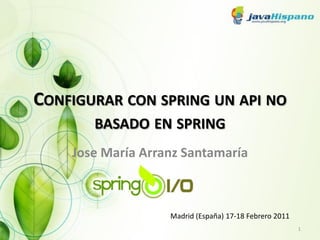

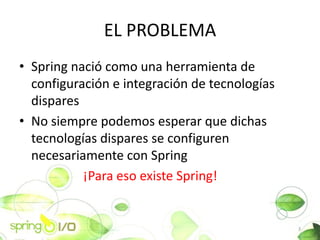
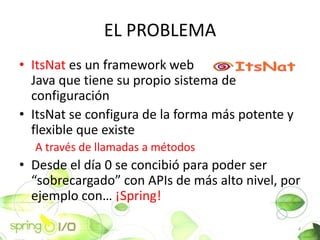




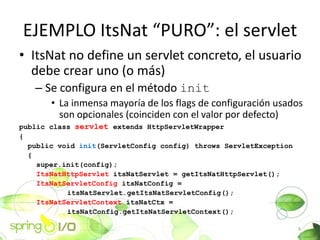

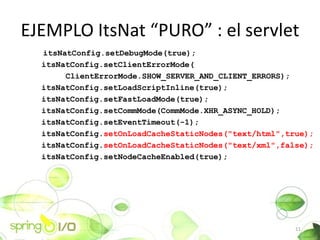
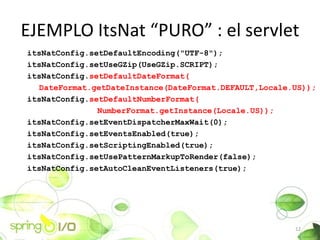
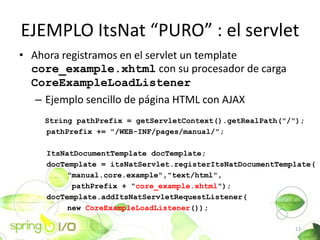
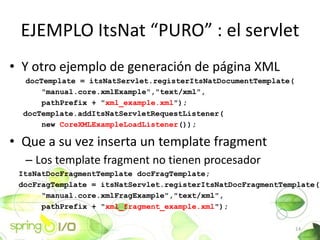
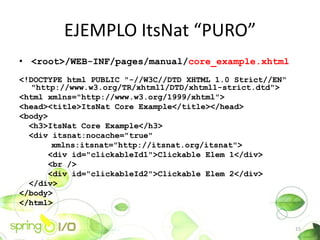
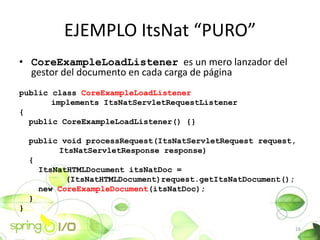
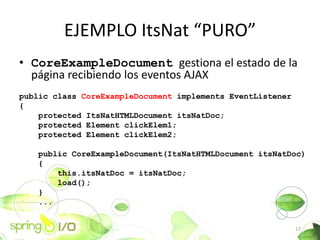
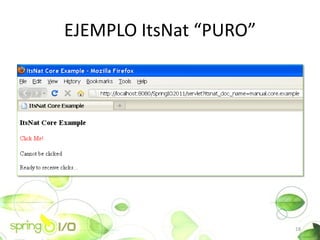

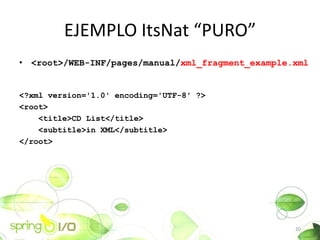

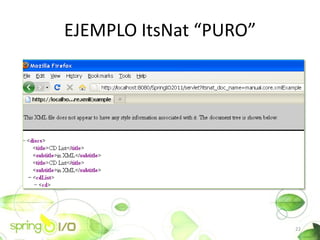
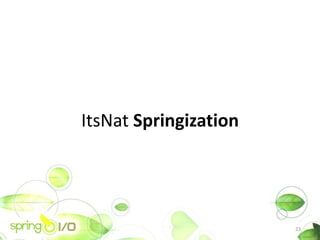
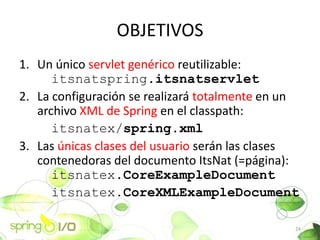
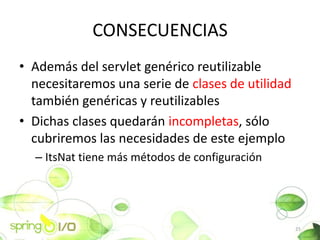

![EL SERVLET
String springXMLPath = config.getInitParameter("spring_config");
if (springXMLPath == null)
throw new RuntimeException("spring_config initialization
parameter is not specified in web.xml");
ApplicationContext context =
new ClassPathXmlApplicationContext(
new String[] {springXMLPath},rootContext);
}
}
? Se registran como singleton los objetos de
configuraci©«n de ItsNat en un
ApplicationContext gen©”rico ra©¬z y se carga
en otro nuevo nuestro XML Spring
27](https://image.slidesharecdn.com/itsnatspringspringiospanish-110221070014-phpapp02/85/Configurar-con-spring-un-api-no-basado-en-spring-27-320.jpg)
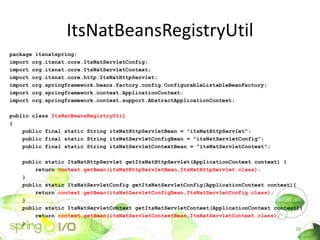
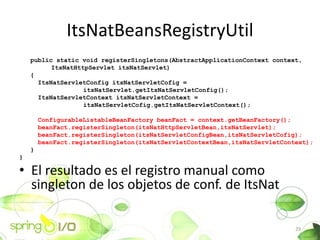
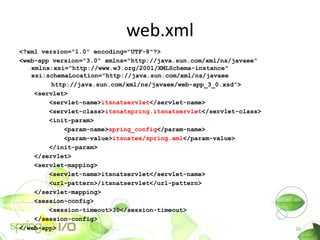
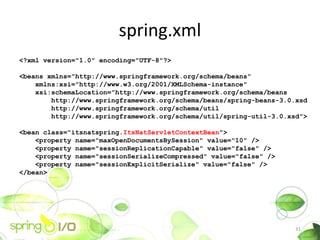
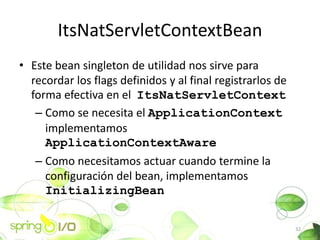
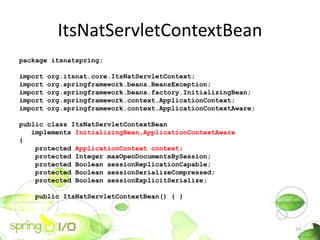

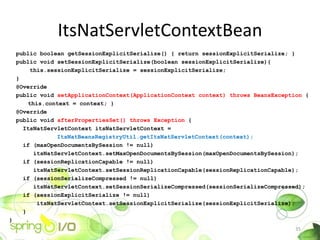
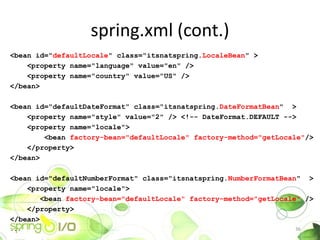
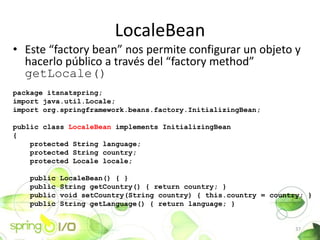
![LocaleBean
public void setLanguage(String language) { this.language = language; }
public Locale getLocale() { return locale; }
@Override
public void afterPropertiesSet() throws Exception
{
Locale[] availablelocales = Locale.getAvailableLocales();
for(Locale locale : availablelocales)
if (locale.getLanguage().equals(language) &&
locale.getCountry().equals(country))
{
this.locale = locale;
return;
}
this.locale = new Locale(language,country);
}
}
38](https://image.slidesharecdn.com/itsnatspringspringiospanish-110221070014-phpapp02/85/Configurar-con-spring-un-api-no-basado-en-spring-38-320.jpg)
